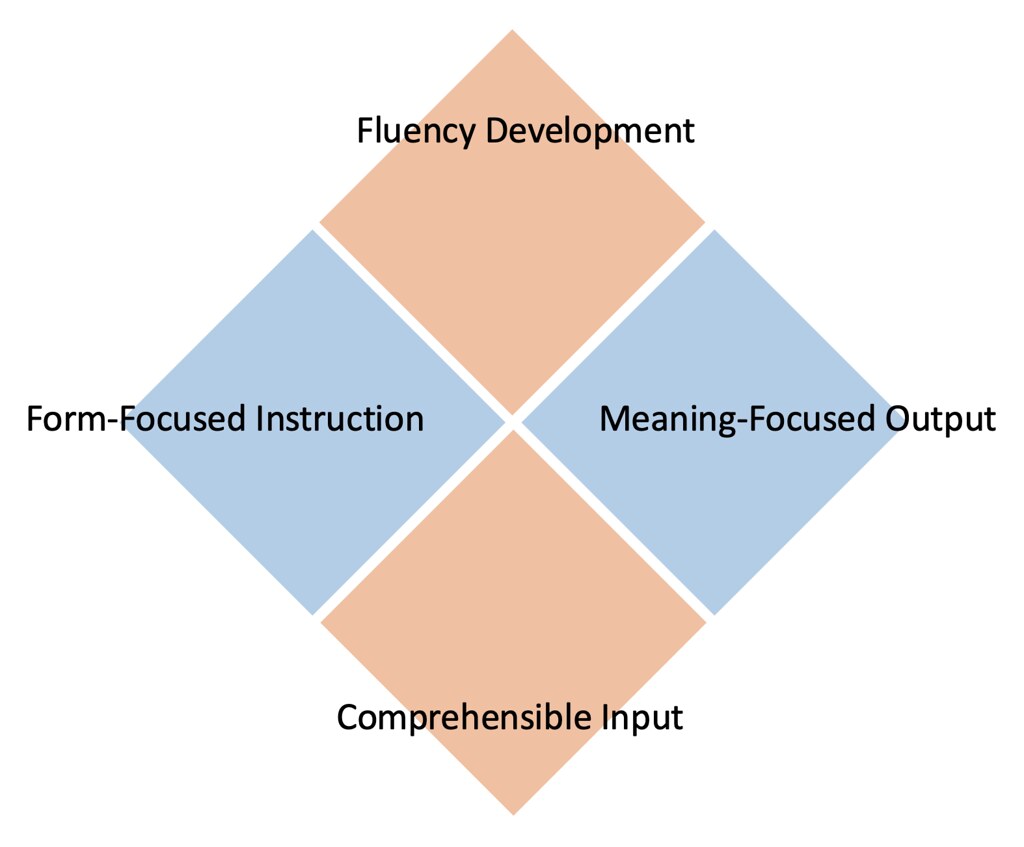The Four Strands of a Balanced Language Course
I’ve been going through some literature in the field of second language acquisition, and this includes Paul Nation’s 2001 work, Learning Vocabulary in Another Language. In case you’re not familiar with him, Paul Nation is regarded as one of the world’s foremost academics in the field of vocabulary acquisition, and his books are well worth reading.
Anyway, I wanted to share what Paul Nation describes as “the four strands” of a “balanced language course.” It’s worth noting that this book was published in 2001, and Paul Nation is not introducing radical new ideas here; he’s simply gently reminding the learner about some facts that researchers in the field of second language acquisition have known for some time. And yet, what follows is probably not going to sound familiar to most of you that have ever studied a foreign language in school. It’s truly jarring just how strong the grip of traditional language teaching in our educational system still is.
The “Four Strands” given by Paul Nation in the introduction of his book are:
Comprehensible Meaning-Focused Input
Firstly there is learning from comprehensible meaning-focused input [see the input hypothesis]. This means that learners should have the opportunity to learn new language items through listening and reading activities where the main focus in on the information in what they are listening to or reading.
Language is all about conveying meaning! (This fact is surprisingly easy to forget.)
Form-Focused Instruction
The second strand is one that has been subject to a lot of debate. This is language-focused learning, sometimes called form-focused instruction (Ellis, 1990). There is growing evidence (Long, 1988; Ellis 1990) that language learning benefits if there is an appropriate amount of usefully-focused deliberate teaching and learning of language items.
This type of learning is what we think of as the traditional “teacher teaching” approach. Obviously, there are also “good ways” and “bad ways” to go about the explicit instruction, but that’s another topic…
Meaning-Focused Output
The third strand is meaning-focused output. Learners should have the chance to develop their knowledge of the language through speaking and writing activities where their main attention is focused on the information they are trying to convey.
Nation also makes the point that focusing on output can really bring focus and meaning to listening and reading activities, as an observant learner can “pick up” how certain information is expressed in the target language.
Fluency Development
The fourth strand in a balanced course is fluency development. In activities which put this strand into action learners do not work with new language; instead, they become more fluent in using items they already know.
“Using items they already know!” I feel like this is blasphemy for some. And yet, yeah, you gotta practice using what you have merely studied. There is an implication here that should not go unnoticed: if you don’t ever focus on “fluency development,” then you don’t develop true fluency.
The Distribution
OK, this is the real kicker. If you’re a teacher, you may be thinking, “yeah, that all sounds fine.” But then how much time would you spend in your curriculum on each of the four strands? Nation mercifully gives us very clear numbers on the ideal distribution:
In a language course, the four strands should get roughly the same amount of time. This means that no more than 25% of the learning time in and out of class should be given to the direct study of language items; no less than 25% of the class time should be given to fluency development. If these strands are not equally represented, then the design of the course needs to be looked at again.
So, to be absolutely clear, this is what Paul Nation is advocating in his book:

…and this is a (somewhat optimistic) representation of what he knows to be the case in most language courses:

The status quo is not good. It doesn’t lead to true fluency.


Great reminders, John! It’s so easy to slip into comfortable habits in language acquisition when we should be striving for balanced progress, including challenging ourselves to construct our own ‘output’ and re-activating previously studied material.
John that’s facinating and extremely useful – I will pick that book up.
I have to look at my 教育方法 after this – I’ve found alot of HSK focused study is based on learning new vocab, studying the ke ben texts and doing exams, but this doesn’t seem to equate to actually being able to speak Chinese at the end of the day
I’ll give you an example from the weekend – I wanted to say to my (chinese) wife, “I haven’t studied Chinese for one week”.
Thinking through In English, I started with something pretty embarrassing like – , 我不学习中文到一个礼拜,我没有学习中文才一个礼拜 and finally 我没有办法学习中文一个星期
I couldnt even say this simple sentence – “I haven’t studied Chinese for one week”.
My wife corrected me ”我有一个礼拜没有学习中文了“
So right now I could do some real damage to a HSK5 paper (but wouldn’t be able to pass it yet), but I can’t say a HSK1 level sentence day to day…I’ve been studying Chinese for 2 years outside of China.
Meaning Focused Output and Fluency Development are almost completely missing (even from the HSK5 孔子学院 class I was in).
I sympathize. Your situation is all too common, and HSK isn’t really helping. Identifying the problem is the first step in solving it, though!
For grammar patterns, the one you mention is on the Chinese Grammar Wiki.